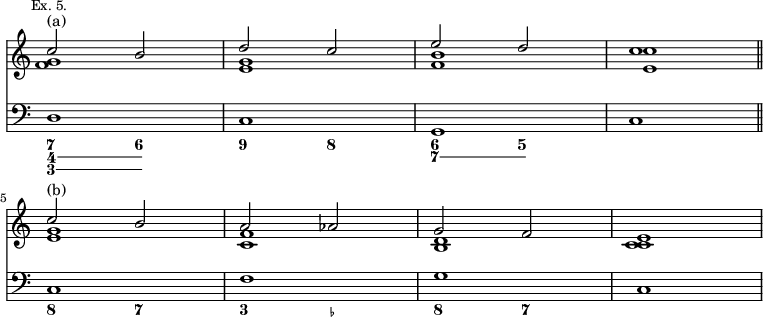
The case of Passing-Notes in the Bass is very different. They appear, of course, in the Continuo itself; and the fact that they really are Passing-Notes, and are, therefore, not intended to bear independent Harmonies, is sufficiently proved by a system of horizontal lines indicating the continuance of a Chord previously figured; as in Example 6, in the first three bars of which the Triad is figured in full, because its intervals are continued on the three succeeding Bass-Notes.

But in no case is the employment of horizontal lines more useful than in that of the Organ Point, which it would often be very difficult to express clearly without their aid. Example 7 shows the most convenient way of figuring complicated Suspensions upon a sustained Bass-Note.
![{ << \new Staff \relative c'' { \override Score.TimeSignature #'stencil = ##f \key g \major \override Score.Rest #'style = #'classical
<< { <cis gis>4 r8 d, d[ c] r fis |
fis[ eis] r <eis b'> b' ais r g' |
g[ fis] r e e[ d] r d | d[ c] r b ais4 b8[ cis] |
ais4. ais8 b4 r } \\
{ <cis, eis> s8 b b[ a] s a | a[ gis] r <gis c> fis2 |
b8[ cis] r g' g[ fis] s fis | e2. d4 | cis4. cis8 d4 r } \\
{ s2. s8 c | c4 r8 s <c f>4 r8 b |
s1 r2 r4 r8 g' | fis4. fis8 fis4 r } >> }
\new Staff { \clef bass cis1 ~ cis2 fis ~ fis1 g2 fis4 e fis2 b, }
\figures { \bassFigureExtendersOn
<5+ _+>4. <9 7>8 q <8 6> s <6\! 4> |
<6 4> <5+ _+>4 <7 _+>8 r <_+>4 <9 4>8 |
<9 4> <8 _+>4 <9 7>8 q <8 6>4 q8 |
<6\! 5>8 <6 4>4 <6 3>8 <7 _+>4 <7\! 5 3> | <_+>2 } >> }](http://upload.wikimedia.org/score/8/8/88syaabspasajngy11csrzohvb776kf/88syaabs.png)
In the Inverted Pedal-Point, the lines are still more valuable, as a means of indicating the continuance of the sustained note in an upper Part; as in Example 8, in which the Figure 8 marks the beginning of the C, which, sustained in the Tenor Part, forms the Inverted Pedal, while the horizontal line indicates its continuance to the end of the passage.

When, in the course of a complicated Movement, it becomes necessary to indicate that a certain phrase—such as the well-known Canto-Fermo in the 'Hallelujah Chorus'—is to be delivered in Unison,—or, at most, only doubled in the Octave—the passage is marked Tasto Solo, or, T. S.—i.e. 'with a single touch' (= key).[1] When the Subject of a Fugue appears, for the first time, in the Bass, this sign is indispensable. When it first appears in an upper Part, the Bass Clef gives place to the Treble, Soprano, Alto, or Tenor, as the case may be, and the passage is written in single Notes, exactly as it is to be played. In both these cases it is usual also to insert the first few Notes of the Answer, as a guide to the Accompanyist, who only begins to introduce full Chords when the figures are resumed. In any case, when the Bass Voices are silent, the lowest of the upper Parts is given in the Thoroughbass, either with or without Figures, in accordance with the law which regards the lowest sound as the real Bass of the Harmony, even though it may be sung by a Soprano Voice. An instance of this kind is shown in Example 9.

We shall now present the reader with a general example, serving as a practical application of the rules we have collected together for his guidance; selecting, for this purpose, the concluding bars of the Chorus, 'All we like sheep,' from Handel's 'Messiah.'
- ↑ As lately as the last century, the keys of the Organ and Harpsichord were called 'Touches' by English writers.
